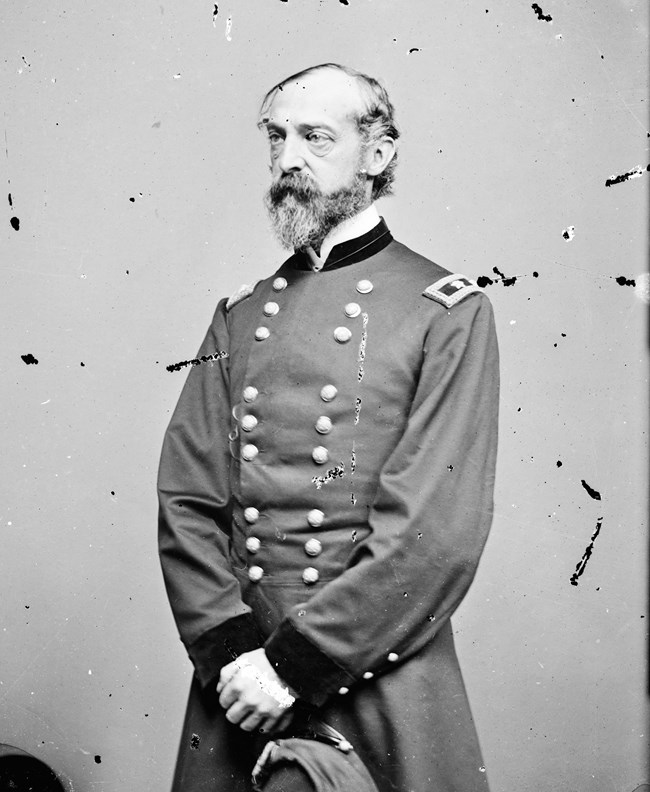Last updated: July 11, 2023
Article
Meade and Lee at Gettysburg

Library of Congress
General George Gordon Meade, US Army of the Potomac
Born in Cadiz, Spain on December 31, 1815, George Gordon Meade was primarily raised in Philadelphia. He entered the US Military Academy at West Point in 1831 and graduated 19th in the Class of 1835. During the Seminole Wars, he was appointed to the 3rd US Artillery in Florida. After an illness he was reassigned to the Watertown Arsenal in Massachusetts for administrative duties. Disillusioned with military life, he resigned his commission in 1836 to work for a railroad company as an engineer. Meade re-entered military service in 1842 to provide a stable home for his wife. In 1845, he was assigned to General Winfield Scott's Army in Texas during the War with Mexico. After the war, Meade returned to Philadelphia where he engineered lighthouses for the Delaware Bay.
At the outbreak of the Civil War, Meade was appointed brigadier general of volunteers in command of a brigade of Pennsylvania regiments. He gained a reputation for being short-tempered and obstinate with junior officers and superiors alike, garnering him the nickname Old Snapping Turtle. At the Battle of Glendale on June 30, 1862, he was seriously wounded though refused to leave the field until the loss of blood so weakened him that he could not remain in the saddle.
Meade recovered and was placed in command of the division of Pennsylvania Reserves. He held this command through the Battles of South Mountain, Antietam, and Fredericksburg. Later that winter, General Joseph Hooker, then in command of the Army of the Potomac, assigned Meade to command the Fifth Army Corps. He participated in the Battle of Chancellorsville in May 1863, and then marched northward that summer once the Army of Northern Virginia crossed the Potomac River. It was still dark on June 28, 1863, while the army camped near Frederick, Maryland, when a courier arrived at Meade's tent bearing the news that he was appointed to command the Army of the Potomac. A surprised Meade protested at first but accepted his assignment and rode to army headquarters. Later that morning, he finished a plan to set the army in motion northward to find Lee.

General Robert E. Lee, Army of Northern Virginia
Born on January 19, 1807 at Stratford in Westmoreland County Virginia, Lee was the son of Anne Hill and Henry Lee, a distinguished cavalry officer during the American Revolution who gained the nick-name Light Horse Harry. Financial problems forced the elder Lee to move his family to a home in Alexandria where Robert attended school and enjoyed outdoor activities along the river. In 1825, the young Lee entered the US Military Academy at West Point. He excelled in his studies and military exercises, graduating second in the class of 1829. Two years later he married Mary Ann Randolph Custis, a direct descendent of Mary Washington. The family moved with Lee's assignments to the midwest and then Washington.
At the outbreak of war with Mexico, Lee was assigned to the army under General John E. Wool and General Winfield Scott and was wounded at the Battle of Chapultepec. Lee distinguished himself during the war and received several promotions in rank after the war ended. In the decade that followed, he briefly served as superintendent of West Point and accepted a command in the 2nd US Cavalry. It was by chance that Lee was in Washington in 1859 when the abolitionist John Brown raided the United States Arsenal at Harpers Ferry. Placed in command of Federal troops sent to recapture the arsenal, Lee directed the soldiers who stormed Brown's last holdout and captured Brown and his fellow conspirators.
In the spring of 1861 Lee was informally offered a command position in the United States Army, but declined and instead offered his services to the Confederate government in Virginia. After serving in several administrative and field positions, he was assigned to command the Confederate Army at Richmond, which he named the Army of Northern Virginia. Under his command, this army exploited Federal mismanagement on numerous battlefields making Lee one of the most victorious commanders in the Confederacy. Lee's success in the field were a stark contrast to the Confederate military operations in the West. As the war went on and the Confederate home front proved increasingly unstable, white Southerners looked towards Lee to provide the victory that would ultimately defeat the United States.
